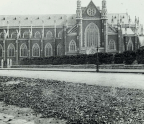
Great leaps forward in design at Melbourne Zoo over the years were followed by tentative steps backwards, or even baffling moves in a whole new direction. These breakthroughs and missteps of the 19th and early 20th century can tell us a lot about the changing values of our society at that time. Should a monkey live in a concrete cage, a forest setting or a modern house? What seems obvious to us now wasn’t always!
Giraffes in the open air
At Melbourne Zoo (Australia’s oldest zoo), public entertainment initially took a back seat to the acclimatisation of livestock, game and songbirds; however, when Albert Le Souef became Melbourne Zoo Director in 1870, he began acquiring the monkeys, bears, lions and tigers that would draw in the crowds.
The animals were initially confined to old circus cages, and the sturdy concrete constructions that followed did little to increase their comfort. The big cats were still caged, and while the bears may have been




